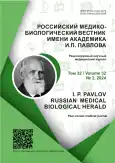Clinical Case of a Foreign Body in the Soft Tissues surrounding the Knee Joint: to Help the Practitione
- Authors: Kosyakov A.V.1
-
Affiliations:
- Ryazan State Medical University
- Issue: Vol 32, No 2 (2024)
- Pages: 281-286
- Section: Clinical reports
- URL: https://bakhtiniada.ru/pavlovj/article/view/260177
- DOI: https://doi.org/10.17816/PAVLOVJ111003
- ID: 260177
Cite item
Abstract
INTRODUCTION: The existence of foreign bodies in a human organism often creates difficulties in differential diagnosis and diagnosis verification.
A clinical case of a 45-year-old female patient is presented. On examination, the patient complained of pain in the knee joints, restricted range of active movements, more on the left. Pain syndrome in the joints has been present for several years intensifying on exertion; a week before the current consultation, the patient fell down from her height on the left knee and felt a sharp enhancement of pain in it. X-ray of the left knee joint showed a fragmented foreign body in the surrounding soft tissues. The patient denied a history of trauma with a foreign body getting into the wound; she cannot give the data and mechanism of appearance of a foreign body in the soft tissues.
CONCLUSION: The peculiarities of the given clinical case include the absence of data on the fact of entry of a foreign body, its prolonged presence in the soft tissues without significant clinical symptoms. A relative rarity of a foreign body in soft tissues, however, does not exclude it being a cause of pain syndrome, the primary care physicians should have diagnostic alertness. A thorough history taking and instrumental examinations are required to exclude, among other things, the presence of an X-ray negative foreign body. Not a single method of examination can be considered ideal for diagnosis of all types of foreign bodies.
Keywords
Full Text
##article.viewOnOriginalSite##About the authors
Aleksey V. Kosyakov
Ryazan State Medical University
Author for correspondence.
Email: Kosyakov_alex@rambler.ru
ORCID iD: 0000-0001-6965-5812
SPIN-code: 8096-5899
MD, Cand. Sci. (Med.)
Russian Federation, RyazanReferences
- Hasak JM, Novak CB, Patterson JMM, et al. Prevalence of needlestick injuries, attitude changes, and prevention practices over 12 years in an urban academic hospital surgery department. Ann Surg. 2018;267(2): 291–6. doi: 10.1097/sla.0000000000002178
- Prüss–Üstün A, Rapiti E, Hutin Y. Estimation of the global burden of disease attributable to contaminated sharps injuries among health-care workers. Am J Ind Med. 2005;48(6):482–90. doi: 10.1002/ajim.20230
- Fedoseyev AV, Chekushin AA, Tishkin RV, et al. Complex Approach in Examination of Function of the Knee Joint in Patients with Osteoarthritis. I. P. Pavlov Russian Medical Biological Herald. 2023;31(2):317–28. (In Russ). doi: 10.17816/PAVLOVJ109633
- Kolesnikov AV, Ban' EV, Kolesnikova MA, et al. Clinical Cases of Eye Damage by Physical Factors. Nauka Molodykh (Eruditio Juvenium). 2023;11(4):573–80. (In Russ). doi: 10.23888/HMJ2023114573-580
- Riddell A, Kennedy I, Tong CYW. Management of sharps injuries in the healthcare setting. BMJ. 2015;351:h3733. doi: 10.1136/bmj.h3733
- Rishi E, Shantha B, Dhami A, et al. Needle stick injuries in a tertiary eye-care hospital: incidence, management, outcomes, and recommendations. Indian J. Ophthalmol. 2017;65(10):999–1003. doi: 10.4103/ijo.ijo_147_17
- Yeung Y, Wong JKW, Yip DKH, et al. A broken sewing needle in the knee of a 4-year-old child: is it really inside the knee? Arthroscopy. 2003;19(8):E18–20. doi: 10.1016/s0749-8063(03)00745-x
- Dai Z–Z, Sha L, Zhang Z–M, et al. Arthroscopic retrieval of knee foreign bodies in pediatric: a single-centre experience. Int Orthop. 2022;46(7):1591–6. doi: 10.1007/s00264-022-05410-4
- Oztekin HH, Aslan C, Ulusal AE, et al. Arthroscopic retrieval of sewing needle fragments from the knees of 3 children. Am J Emerg Med. 2006;24(4):506–8. doi: 10.1016/j.ajem.2005.12.011
- Koval AN, Tashkinov NV, Melkonyan GG, et al. Optimization of removal of X-ray visualized foreign bodies of soft tissues. Yakut Medical Journal. 2020;(1):112–5. (In Russ). doi: 10.25789/YMJ.2020.69.28
- Hsiang–Jer T, Hanna TN, Shuaib W, et al. Imaging Foreign Bodies: Ingested, Aspirated, and Inserted. Ann Emerg Med. 2015;66(6):570–82.e5. doi: 10.1016/j.annemergmed.2015.07.499
- Jacobson JA, Powell A, Craig JG, et al. Wooden foreign bodies in soft tissue: detection at US. Radiology. 1998;206(1):45–8. doi: 10.1148/radiology.206.1.9423650
- Borgohain B, Borgohain N, Handique A, et al. Case report and brief review of literature on sonographic detection of accidentally implanted wooden foreign body causing persistent sinus. Crit Ultrasound J. 2012;4(1):10. doi: 10.1186/2036-7902-4-10
- Barr L, Hatch N, Roque PJ, et al. Basic ultrasound-guided procedures. Crit Care Clin. 2014;30(2):275–304. doi: 10.1016/j.ccc.2013. 10.004
- Tintinalli JE, Ma OJ, Yealy DM, et al. Tintinalli's Emergency Medicine: A Comprehensive Study Guide. 9nd ed. McGraw Hill; 2019.
- Krimmel M, Cornelius CP, Stojadinovic S, et al. Wooden foreign bodies in facial injury: a radiological pitfall. Int J Oral Maxillofac Surg. 2001;30(5):445–7. doi: 10.1054/ijom.2001.0109
- Jarraya M, Hayashi D, de Villiers RV, et al. Multimodality imaging of foreign bodies of the musculoskeletal system. AJR Am J Roentgenol. 2014;203(1):W92–102. doi: 10.2214/ajr.13.11743
Supplementary files








